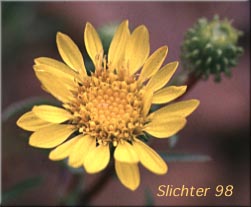 The photo at right shows a view down onto the flowerhead of low gumweed (var. nana) from Steptoe Butte, Palouse country in eastern Washington.........6/27/98.
The photo at right shows a view down onto the flowerhead of low gumweed (var. nana) from Steptoe Butte, Palouse country in eastern Washington.........6/27/98.
Low gumweed is a smooth-surfaced perennial, having a taproot and many branched stems. It ranges in height from 10 to 80 cm. The leaves are largest near the base of the stems, and reduced in size towards the tips. Each leaf is spiny margined to entire, with the lower leaves oblanceolate and occasionally clasping at the stem, and the smaller upper leaves more often with clasping bases. Both the leaves and stems are glabrous.
The flower heads have both ray and disk flowers. The involucre (or bracts below the flowers) are conspicuously spiny-tipped, with the spines arcing outwards. The bracts are also distinctly non-resinous.
The flower heads of variety nana have a disk about 8 to 15 mm across, and an involucre about 1 cm tall. Variety integrifolia has disks to 25 mm across, and an involucre 10 to 17 mm high. The species has roughly 12 to 25 ray flowers.
Low gumweed is found in dry open places in the lowlands and into the foothills.
Variety Grindelia nana var. nana is found primarily in eastern Washington and northern Idaho, and southward to Union County, OR.
Variety Grindelia nana var. integrifolia is found in the range of the species, from eastern Washington and eastern Washington, extending east to western Montana, and also found in northwestern California and southwestern Oregon. It may occur at other western locations as an introduced weedy species.
In the Columbia River Gorge, low gumweed is found east of the mouth of the Deschutes River at elevations below 200'.